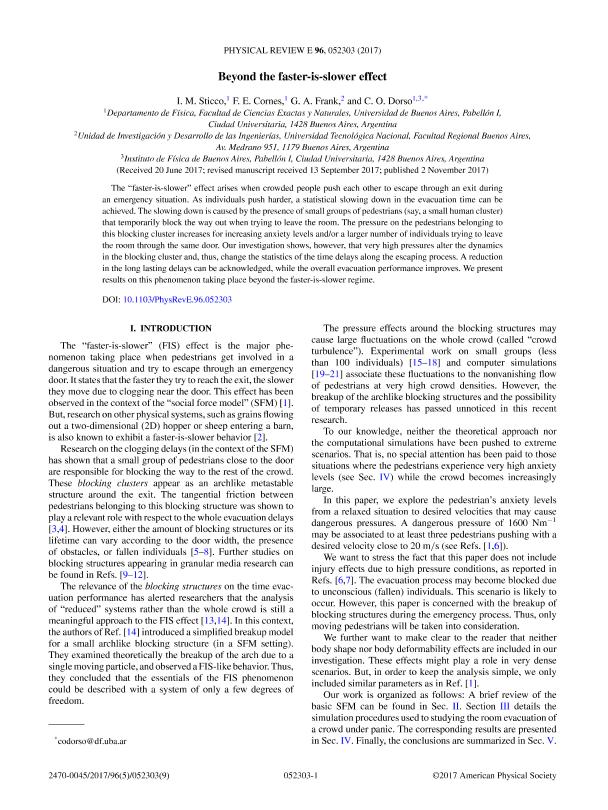Mostrar el registro sencillo del ítem
dc.contributor.author
Sticco, Ignacio Mariano

dc.contributor.author
Cornes, Fernando Ezequiel

dc.contributor.author
Frank, Guillermo Alberto

dc.contributor.author
Dorso, Claudio Oscar

dc.date.available
2018-12-05T19:12:14Z
dc.date.issued
2017-11
dc.identifier.citation
Sticco, Ignacio Mariano; Cornes, Fernando Ezequiel; Frank, Guillermo Alberto; Dorso, Claudio Oscar; Beyond the faster-is-slower effect; American Physical Society; Physical Review E; 96; 5; 11-2017; 1-9
dc.identifier.issn
2470-0053
dc.identifier.uri
http://hdl.handle.net/11336/65908
dc.description.abstract
The "faster-is-slower" effect arises when crowded people push each other to escape through an exit during an emergency situation. As individuals push harder, a statistical slowing down in the evacuation time can be achieved. The slowing down is caused by the presence of small groups of pedestrians (say, a small human cluster) that temporarily block the way out when trying to leave the room. The pressure on the pedestrians belonging to this blocking cluster increases for increasing anxiety levels and/or a larger number of individuals trying to leave the room through the same door. Our investigation shows, however, that very high pressures alter the dynamics in the blocking cluster and, thus, change the statistics of the time delays along the escaping process. A reduction in the long lasting delays can be acknowledged, while the overall evacuation performance improves. We present results on this phenomenon taking place beyond the faster-is-slower regime.
dc.format
application/pdf
dc.language.iso
eng
dc.publisher
American Physical Society

dc.rights
info:eu-repo/semantics/openAccess
dc.rights.uri
https://creativecommons.org/licenses/by-nc-sa/2.5/ar/
dc.subject
Active Mattera
dc.subject
Pedestrian Simulation
dc.subject.classification
Astronomía

dc.subject.classification
Ciencias Físicas

dc.subject.classification
CIENCIAS NATURALES Y EXACTAS

dc.title
Beyond the faster-is-slower effect
dc.type
info:eu-repo/semantics/article
dc.type
info:ar-repo/semantics/artículo
dc.type
info:eu-repo/semantics/publishedVersion
dc.date.updated
2018-10-23T18:16:00Z
dc.journal.volume
96
dc.journal.number
5
dc.journal.pagination
1-9
dc.journal.pais
Estados Unidos

dc.journal.ciudad
Nueva York
dc.description.fil
Fil: Sticco, Ignacio Mariano. Consejo Nacional de Investigaciones Científicas y Técnicas; Argentina. Universidad de Buenos Aires. Facultad de Ciencias Exactas y Naturales. Departamento de Física; Argentina
dc.description.fil
Fil: Cornes, Fernando Ezequiel. Consejo Nacional de Investigaciones Científicas y Técnicas; Argentina. Universidad de Buenos Aires. Facultad de Ciencias Exactas y Naturales. Departamento de Física; Argentina
dc.description.fil
Fil: Frank, Guillermo Alberto. Consejo Nacional de Investigaciones Científicas y Técnicas; Argentina. Universidad Tecnológica Nacional. Facultad Regional Buenos Aires. Unidad de Investigación y Desarrollo de las Ingenierías; Argentina
dc.description.fil
Fil: Dorso, Claudio Oscar. Consejo Nacional de Investigaciones Científicas y Técnicas. Oficina de Coordinación Administrativa Ciudad Universitaria. Instituto de Física de Buenos Aires. Universidad de Buenos Aires. Facultad de Ciencias Exactas y Naturales. Instituto de Física de Buenos Aires; Argentina. Universidad de Buenos Aires. Facultad de Ciencias Exactas y Naturales. Departamento de Física; Argentina
dc.journal.title
Physical Review E

dc.relation.alternativeid
info:eu-repo/semantics/altIdentifier/url/https://journals.aps.org/pre/abstract/10.1103/PhysRevE.96.052303
dc.relation.alternativeid
info:eu-repo/semantics/altIdentifier/doi/https://doi.org/10.1103/PhysRevE.96.052303
Archivos asociados
